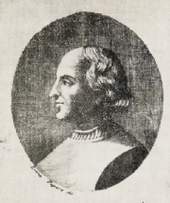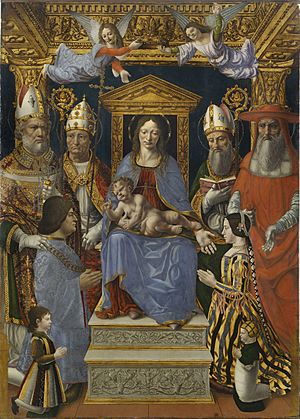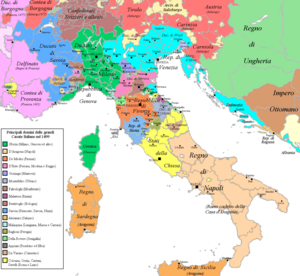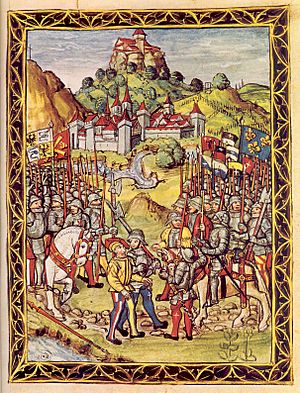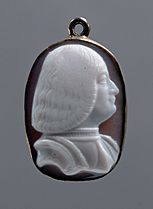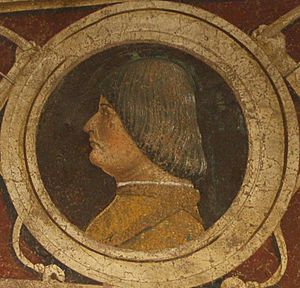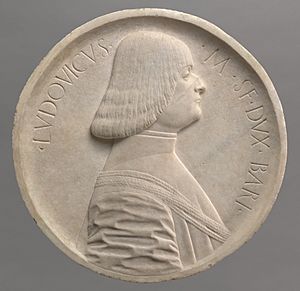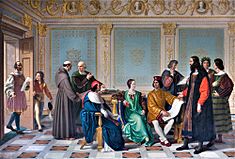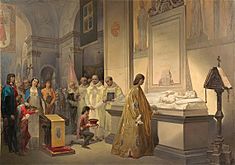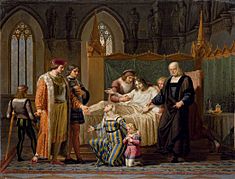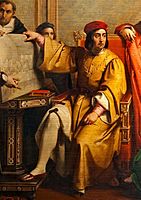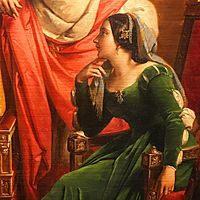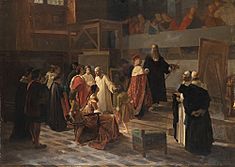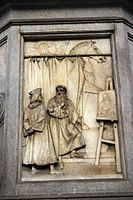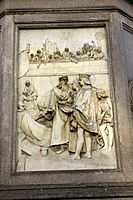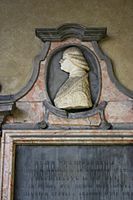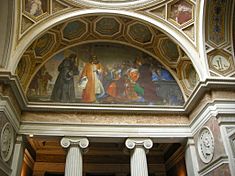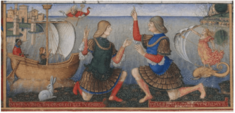Ludovico Sforza facts for kids
Quick facts for kids Ludovico Sforza |
|
|---|---|

Ludovico's portrait in the Pala Sforzesca, 1494–1495 (Pinacoteca di Brera in Milan)
|
|
| Duke of Milan | |
| Reign | 21 October 1494 – 6 September 1499 |
| Predecessor | Gian Galeazzo Sforza |
| Successor | Louis XII of France |
| Regent of Milan | |
| Regency | 7 October 1480 – 21 October 1494 |
| Monarch | Gian Galeazzo Sforza |
| Born | 27 July 1452 Vigevano, Duchy of Milan |
| Died | 27 May 1508 (aged 55) Château de Loches |
| Spouse | Beatrice d'Este |
| Issue Detail |
|
| House | Sforza |
| Father | Francesco I Sforza |
| Mother | Bianca Maria Visconti |
Ludovico Maria Sforza (born July 27, 1452 – died May 27, 1508), also known as Ludovico il Moro ("the Moor"), was an important Italian nobleman during the Italian Renaissance. He ruled as Duke of Milan from 1494 to 1499.
Ludovico was known for being smart and very ambitious. He first became the ruler of Milan by taking control from his sister-in-law, Bona of Savoy. Later, he took over from his nephew, Gian Galeazzo. Ludovico was a great supporter of artists and writers. During his time as ruler, his court in Milan became one of the most important in Europe.
To protect Milan from King Alfonso II of Naples, Ludovico asked the French for help. But when the French became a threat, he struggled to handle the danger. He only escaped thanks to his wife, Beatrice d'Este. After she passed away, Ludovico became very sad. His court changed from a happy place to a dark one. He was eventually captured by King Louis XII of France and taken prisoner. He spent the rest of his life in France.
Contents
Early Life and Education
Childhood and Learning
Ludovico Sforza was born on July 27, 1452, in Vigevano, Italy. He was the fourth son of Francesco I Sforza and Bianca Maria Visconti. Because he was not the oldest son, he wasn't expected to become the ruler of Milan. However, his mother made sure he received an excellent education.
Ludovico studied many subjects, including painting, sculpture, and literature. He also learned about government and warfare. His teachers, like the humanist Francesco Filelfo, made sure he had a broad education. He learned Greek, Latin, and theology. He also practiced physical activities like fencing, hunting, and horseback riding. People described him as a quick and eager learner.
Life Under His Brother's Rule
In 1466, Ludovico's father, Francesco, died. His older brother, Galeazzo Maria Sforza, became the new Duke. Ludovico was given the title of Count of Mortara. He helped his brother with important diplomatic tasks. He traveled to Genoa to welcome his sister Ippolita and later escorted Bona of Savoy to Milan for her wedding to Duke Galeazzo Maria.
Ludovico also served as an ambassador to the King of France and visited Venice and Rome for important events. His brother Galeazzo Maria seemed to favor him. However, in 1476, Ludovico was sent to France, which was like a hidden exile.
Rise to Power in Milan
Taking Control
On December 26, 1476, Duke Galeazzo Maria was killed. His son, Gian Galeazzo Maria, who was only seven years old, became the new Duke. Ludovico Sforza quickly returned from France. He and his brothers tried to stop Bona of Savoy from ruling as regent, as the powerful ducal advisor Cicco Simonetta was truly in charge.
Their attempt failed, and Ludovico was sent away to Pisa. However, Ludovico and his brother soon returned with an army. Bona of Savoy and Cicco Simonetta tried to stop them. On March 1, Ludovico and his brother were declared rebels.
Later, peace talks began. On September 7, Ludovico entered the castle of Milan. Simonetta, who was very smart, warned Duchess Bona that she would lose power if she let Ludovico in.
Some Milanese nobles wanted to get rid of Simonetta. Ludovico didn't see Simonetta as a threat at first. But fearing a public uprising, he had Simonetta imprisoned.
Simonetta's Death and Bona's Exile
After gaining power, Ludovico brought his brother Ascanio and Roberto Sanseverino back to Milan. He worked to build alliances with other Italian states. However, Ludovico soon exiled his brother Ascanio and other nobles who had helped him.
On October 30, Cicco Simonetta was executed. This removed Ludovico's main opponent. Duchess Bona, influenced by her lover, tried to replace the castle's prefect. But the prefect remained loyal to the young Duke Gian Galeazzo.
Ludovico then secretly moved his nephews, Gian Galeazzo and Ermes, to the castle. He called a council there. Bona was forced to agree to her lover's exile. On November 3, 1480, Bona gave up her role as regent to Ludovico. He became the tutor of the young Duke Gian Galeazzo.
Ludovico as Regent (1480–1494)
Engagement to Beatrice d'Este
Ludovico had initially thought about marrying his sister-in-law Bona to become Duke. But Bona wanted to get rid of him and suggested he marry Isabella d'Este, the daughter of Ercole d'Este, Duke of Ferrara. Isabella was already promised to someone else. So, Ercole d'Este offered his second daughter, Beatrice d'Este, who was only five years old.
Ludovico was happy with this arrangement. Beatrice was being raised in Naples by King Ferrante, her grandfather. This marriage would create an alliance with both the King of Naples and the Duke of Ferrara. The engagement took place on April 30, 1481. In 1485, Beatrice returned to Ferrara to prepare for her future role.
War of Ferrara
In May 1482, the Republic of Venice started a war against the Duchy of Ferrara. Ludovico supported his future father-in-law, Ercole d'Este. He sent his troops to help Ferrara.
Ludovico's forces had some successes. However, disagreements arose between Ludovico and Alfonso of Aragon. Alfonso worried that Ludovico wanted to take over his nephew Gian Galeazzo's power. The Venetians offered Ludovico peace in exchange for money. Ludovico accepted, even though it went against Ercole d'Este's wishes.
Marriage and Family Life
Ludovico's fiancée, Beatrice, was old enough to marry. Ludovico delayed the wedding a few times, which confused her family. The wedding was finally set for January 1491. On December 29, 1490, Beatrice traveled from Ferrara to Milan.

On January 18, 1491, Ludovico married Beatrice in the Ducal Chapel of the castle of Pavia. He chose Pavia instead of Milan to avoid seeming like he was trying to overshadow Gian Galeazzo, the rightful Duke.
A Strong Partnership
Ludovico and Beatrice had a very loving relationship. People noticed how much Ludovico cared for his wife. He often kissed and caressed her. He wrote that she was "dearer to me than the light of the sun." Beatrice also seemed to love him deeply. She often traveled with him, even during her pregnancies. They were seen as an ideal couple.
Beatrice quickly charmed the Milanese court with her lively personality. She helped make Sforza Castle a center for grand parties and events. She enjoyed hosting philosophers, poets, and soldiers. Beatrice had excellent taste. She encouraged Ludovico to support artists like Leonardo da Vinci and Donato Bramante. She became the mother of Maximilian Sforza and Francesco II Sforza, who would both become Dukes of Milan.
Becoming Duke and Italian Wars
Gian Galeazzo and his wife Isabella moved to Pavia after their wedding. Gian Galeazzo didn't seem interested in ruling, but Isabella disagreed with Beatrice. Beatrice wanted her son, Ercole Massimiliano, born in 1493, to be named Count of Pavia, a title for the heir to the Duchy.
Isabella asked her grandfather, King Ferrante of Naples, to help her husband gain control of the Duchy. Ferrante didn't want a war. When Ferrante died, his successor, Alfonso, attacked Bari, showing his anger towards Ludovico.
To respond, Ludovico allied with Emperor Maximilian and King Charles VIII of France. He allowed Charles VIII to invade Italy to conquer Naples. Maximilian promised to recognize Ludovico as the Duke of Milan. To seal this promise, Maximilian married Bianca Maria Sforza, Gian Galeazzo's sister. She brought a huge dowry with her.
On September 11, 1494, Charles VIII arrived in Asti. Ludovico and Beatrice welcomed him with great honors. However, Ludovico and Beatrice didn't truly want Charles to conquer Naples. They just wanted to scare King Alfonso II and keep him busy. Ludovico hoped other Italian lords would stop Charles. But Charles easily moved through Italy.
Ludovico then became worried about the French influence. He decided to change alliances and join the Holy League against France.
Becoming Duke of Milan
On October 22, 1494, Duke Gian Galeazzo died suddenly. Many people, including famous historians, believed Ludovico had poisoned him. However, some scholars disagree, pointing out that Gian Galeazzo had been ill for a long time.
The Milanese nobles chose Ludovico to succeed Gian Galeazzo, even though there were other rightful heirs. This was the peak of Ludovico's political power.
Charles VIII had easily reached Naples. But Ludovico had only wanted to use Charles to scare Alfonso II. Ludovico had expected other Italian states to stop Charles, but they didn't. Ludovico grew very concerned about the French. He decided to switch alliances again and join the Holy League against France.
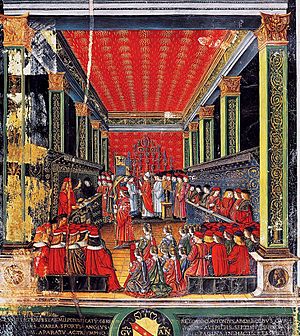
The Siege of Novara
To counter the threats from Louis d'Orléans, Ludovico planned to attack Asti. But Louis d'Orléans acted first. On June 11, he captured Novara and advanced towards Vigevano.
Ludovico and his family took refuge in the Milan castle. He even considered fleeing to Spain. However, his wife Beatrice and some advisors convinced him to stay and fight. The state was facing financial problems, and there was fear of a public uprising.
Some historians believed Ludovico was very stressed and unable to act. But Beatrice, who was appointed governor of Milan, stepped up. She ensured the loyalty of the nobles. She then went to the military camp to encourage the captains to fight Louis d'Orléans. Her strong presence made Louis d'Orléans hesitate, giving Milan time to reorganize its defenses. This hesitation was a mistake for him, as it allowed Ludovico's forces to surround him in Novara.
| [[Image:{{{2}}}|{{{3}}}px|]] | [[Image:{{{4}}}|{{{5}}}px|]] | |
On July 6, 1495, the Battle of Fornovo took place. The League forces suffered heavy losses. Ludovico had even used bronze meant for a statue by Leonardo da Vinci to make cannons.
By early August, Ludovico had recovered and joined his wife at the Novara camp. They held a large military parade for Beatrice, who enjoyed seeing the troops.
On September 24, a fight broke out. Francesco Gonzaga had to intervene to protect Beatrice, as some German soldiers were angry. Ludovico was very relieved that Beatrice was safe.
The Novara garrison was weakened by hunger and disease. Louis d'Orléans himself was sick. He eventually had to surrender. This event was a great success for Ludovico.
Beatrice's Death
| [[Image:{{{2}}}|{{{3}}}px|]] | [[Image:{{{4}}}|{{{5}}}px|]] | |
In 1496, the relationship between Ludovico and Beatrice became strained. Sadly, Beatrice died during childbirth on January 2 or 3, 1497. She was also deeply saddened by the death of her young friend, Bianca Giovanna Sforza.
Ludovico's Grief
| [[Image:{{{2}}}|{{{3}}}px|]] | [[Image:{{{4}}}|{{{5}}}px|]] | |
Ludovico was heartbroken by Beatrice's death. He never fully recovered. She had been his strength and support in ruling Milan. He had always believed he would die before her. He had placed all his hopes for the state's future in her abilities.
Many people believed Beatrice's death was a major disaster for Ludovico. She was the driving force behind his plans and the true queen of his heart and court. When she died, it was like a great storm that upset Ludovico's spirit. He never recovered from it. Her death marked the beginning of his misfortunes. He felt alone and became more religious.
| [[Image:{{{2}}}|{{{3}}}px|]] | [[Image:{{{4}}}|{{{5}}}px|]] | |
Ludovico often remembered his wife. He even had a coin minted with her image on one side, which was very unusual. He also used her family's coat of arms more often. He commissioned a beautiful funeral monument with their figures carved in marble. He said he hoped to rest next to her until the end of the world.
Downfall and Capture
| [[Image:{{{2}}}|{{{3}}}px|]] | [[Image:{{{4}}}|{{{5}}}px|]] | |
In 1498, Charles VIII died without children. Louis d'Orléans became King Louis XII of France. He decided to invade the Duchy of Milan again. Without Beatrice's help, Ludovico struggled to face the enemy.
Louis XII gave command of his army to Gian Giacomo Trivulzio, a personal enemy of Ludovico. Ludovico tried to make new alliances. He helped Florence against Pisa, hoping Florence would help him against France. This turned out to be a bad move. He lost Venice as an ally, and Florence didn't help him much.
Louis XII allied with Venice, and Trivulzio's army entered Italy. Ludovico chose to flee. He left Milan on September 1, 1499, with his sons and brother Ascanio, seeking refuge with Emperor Maximilian I. The people of Milan, tired of high taxes, revolted. Trivulzio entered Milan in triumph.
Some historians blame Ludovico for inviting foreign invasions into Italy. However, more recent historians have reevaluated his role.
Ludovico heard rumors that the Milanese people were unhappy with French rule. He hired Swiss soldiers and, in early 1500, tried to retake Milan. He told the people he now preferred being a military captain to a lord.
However, during the siege of Novara, the Swiss soldiers refused to fight. On April 10, as the Swiss were leaving Novara, Ludovico tried to sneak out disguised as a mercenary. But one mercenary recognized him and gave him away. Ludovico was captured by the French. His brother Ascanio was also captured a few days later.
With the French arrival, Milan lost its independence for many years. The French took many treasures, including the large Visconti-Sforza Library from Pavia Castle. Many of its valuable manuscripts are now in the National Library of France.
The mercenary who betrayed Ludovico was rewarded by the French. But later, when he returned home, he was arrested for treason and executed.
Imprisonment and Death
Ludovico was taken prisoner to France. King Louis XII refused to meet him, even though Emperor Maximilian asked for his release. However, Ludovico was treated as a special prisoner. He was allowed to fish and receive friends.
He was held in different castles. In 1504, he was moved to the castle of Loches and given more freedom. In 1508, Ludovico tried to escape. After that, he was kept in the castle's dungeon and lost his privileges. He died there on May 27, 1508.
Later, the Swiss helped restore the Duchy of Milan to Ludovico's son, Maximilian Sforza. His other son, Francesco II, also ruled for a short time. After Francesco II died in 1535, Milan became part of the Spanish Empire.
Appearance and Personality
Ludovico's Character
Ludovico was a good ruler during times of peace. He was not a fighter and avoided violence. He preferred to stay away from battles and rarely gave harsh punishments. He was known for being kind, understanding, and thoughtful. He was also generous with his friends.
He was an elegant and handsome man. He was cultured and enjoyed reading and music. He was also interested in farming and introduced new crops. He created fair laws for his people. Many people saw him as a complete gentleman of the Italian Renaissance.
Ludovico was not known for being a "tyrant." That label might fit his brother, Galeazzo Maria Sforza, better. Ludovico learned from his brother's example and avoided extremes. Even when he was imprisoned by King Louis XII, he wrote a guide for the king on how to govern Lombardy. He advised the king to be kind to the Florentines, not to anger the Pope, and never to trust the Venetians.
Physical Appearance
Ludovico was quite tall for his time, about 1.8 to 1.9 meters (about 5 feet 11 inches to 6 feet 3 inches). He enjoyed good food and gained weight over the years. After his wife's death and his capture, he lost weight due to fasting. But later, he gained it back.
He often wore clothes that reached just above his knees. He had broad shoulders, which he sometimes highlighted with gold chains. From a young age, he had dark eyes, dark hair, and a dark complexion. This is why he was called "the Moor." People described him as having a noble and beautiful appearance. In his later years, he suffered from gout and asthma.
His Personality Traits
Ludovico was very human and patient. He listened to people and was generous to talented artists and writers. He also cared for his people during times of famine or plague. He improved the city and brought wealth to Lombardy. People called him a "builder of golden peace."
Sometimes, he could be boastful. For example, he once claimed that the Pope was his chaplain and the Emperor was his general. He was described as very smart but also fearful in difficult times. He showed his fear with tears.
One chronicler said he was a man who only loved others out of fear or need. He was described as dishonest, vengeful, greedy, and without shame. He was also seen as very timid and not to be trusted. He believed he could underestimate other powerful leaders in Italy, which led him to lose friends.
The chronicler Andrea Prato said Ludovico was smart but fearful. He disliked battles and even hearing about cruel things. Because of this, soldiers didn't like him, as they wanted a brave leader by their side.
His wife, Beatrice, had a strong character and loved war. She made up for his weaknesses. She was his most loyal helper. Her death led to his downfall. He trusted Beatrice completely and gave her important tasks. He always included her in war councils and negotiations. As a husband, he was almost perfect, especially at the beginning.
He was also a caring and loving father. He showed great love for his daughter, Bianca Giovanna, and was deeply saddened by her early death.
Love for the Land
Ludovico's greatest passion was agriculture. He liked to remember that his grandfather was a farmer. Ludovico himself was an expert in growing grapevines and mulberry trees. Mulberry trees were important for feeding silkworms, which made Milan's silk industry famous.
He created his own farm near Vigevano, called Sforzesca. It had areas for raising cattle, sheep, and other animals, which he loved to visit with Beatrice. He used Leonardo da Vinci's skills as an engineer to build aqueducts to water the dry lands. In 1494, he gave the Sforzesca farm and other lands to his beloved Beatrice. This was a significant gift, as the farm brought in a lot of money each year.
He also invested in horse and cattle breeding and the metal industry. About 20,000 people worked in the silk industry. He supported many projects in civil and military engineering, like canals and forts. He continued work on the Cathedral of Milan and the Certosa of Pavia. He also made Milan's streets wider and added gardens. The University of Pavia thrived under his rule. However, there were some protests and riots due to the high taxes needed to pay for these projects.
Interest in Astrology
Perhaps because he was insecure, Ludovico was very interested in astrology. His courtiers noticed that nothing was done in Milan unless his astrologer and personal doctor, Ambrose of Rosate, had first checked the stars.
His Love for Culture
Ludovico was a cultured man. He knew Latin and French. He enjoyed listening to daily readings and discussions of the Divine Comedy, which his wife Beatrice loved. After her death and his capture, Ludovico asked to keep a copy of Dante's work with him. He read it constantly during his captivity and even wrote lines from it, translated into French, on the walls of his cell.
Origin of the Nickname "Moro"
Ludovico earned the nickname "Moro" (the Moor) as a child. This is what people called him when he appeared in public. At the time, "Moors" referred to people from Africa or Saracens. So, the most common explanation is that his nickname came from his dark complexion, dark hair, and black eyes. Many of his portraits show these features, and a chronicler of the time confirmed it.
Ludovico in Art
Ludovico and his court of artists became popular subjects in 19th-century art. Events like his deep sadness after Beatrice's death, the suspected poisoning of Duke Gian Galeazzo, and the presence of artists like Leonardo da Vinci inspired painters. Artists such as Giambattista Gigola, Giuseppe Diotti, Francesco Gonin, Francesco Podesti, Cherubino Cornienti, and Eleanor Fortescue-Brickdale created works about him.
-
The Forerunner or The Court of Ludovico il Moro. Eleanor Fortescue-Brickdale.
Family and Children
Legitimate Children
With his wife Beatrice d'Este, Ludovico had the following children:
- Ercole Massimiliano (1493–1530): He was Count of Pavia and Duke of Milan from 1513 to 1515.
- Sforza Francesco (1495–1535): He was Prince of Rossano and Count of Borrello. He later became Count of Pavia and Duke of Milan from 1521 to 1524. In 1533, he married Christina of Denmark.
- A third son was born dead in 1497. Ludovico was heartbroken. He had the baby buried above the door of the Santa Maria delle Grazie cloister.
Other Children
Ludovico also had several children with other women. These children were all officially recognized.
- From Bernardina de Corradis, he had:
- Bianca Giovanna (1482–1496): She married Galeazzo Sanseverino.
- From Cecilia Gallerani, he had one son:
- Cesare (1491–1514): He became an abbot and canon.
- From Lucrezia Crivelli, he had two children:
- Giovanni Paolo I Sforza (1497–1535): He was the ancestor of the Sforza branch of Caravaggio.
- Another child, likely born around 1500.
- From Romana, he had:
- Leone (1476–1496): He married Margherita Grassi.
- From other women, he had:
- Galeazzo: His eldest son, born before 1476, who died as a child.
- Sforza (1484/1485–1487).
See also
 In Spanish: Ludovico Sforza para niños
In Spanish: Ludovico Sforza para niños


